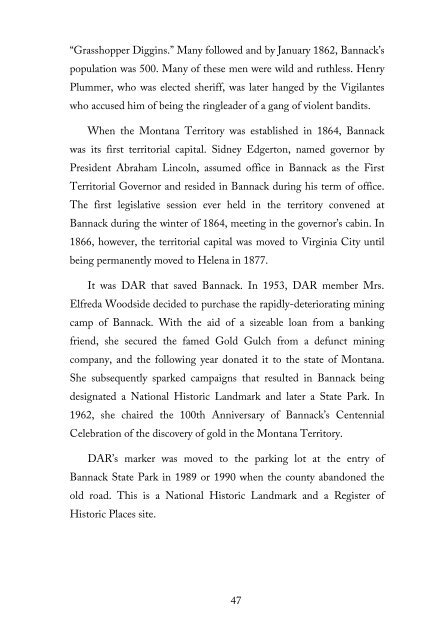Montana's DAR Markers . . . Honoring Where History Was Made
This book is a 200-page thank you to the women of Montana State Society Daughters of the American Revolution for their work in placing historical markers across the state of Montana. Starting in 1908, Montana DAR has installed 70 historical markers across the state. Of those, 33 remain. This book records why the markers’ sites were selected, their history, and the backstory of each.
This book is a 200-page thank you to the women of Montana State Society Daughters of the American Revolution for their work in placing historical markers across the state of Montana. Starting in 1908, Montana DAR has installed 70 historical markers across the state. Of those, 33 remain. This book records why the markers’ sites were selected, their history, and the backstory of each.
Create successful ePaper yourself
Turn your PDF publications into a flip-book with our unique Google optimized e-Paper software.
“Grasshopper Diggins.” Many followed and by January 1862, Bannack’s<br />
population was 500. Many of these men were wild and ruthless. Henry<br />
Plummer, who was elected sheriff, was later hanged by the Vigilantes<br />
who accused him of being the ringleader of a gang of violent bandits.<br />
When the Montana Territory was established in 1864, Bannack<br />
was its first territorial capital. Sidney Edgerton, named governor by<br />
President Abraham Lincoln, assumed office in Bannack as the First<br />
Territorial Governor and resided in Bannack during his term of office.<br />
The first legislative session ever held in the territory convened at<br />
Bannack during the winter of 1864, meeting in the governor’s cabin. In<br />
1866, however, the territorial capital was moved to Virginia City until<br />
being permanently moved to Helena in 1877.<br />
It was <strong>DAR</strong> that saved Bannack. In 1953, <strong>DAR</strong> member Mrs.<br />
Elfreda Woodside decided to purchase the rapidly-deteriorating mining<br />
camp of Bannack. With the aid of a sizeable loan from a banking<br />
friend, she secured the famed Gold Gulch from a defunct mining<br />
company, and the following year donated it to the state of Montana.<br />
She subsequently sparked campaigns that resulted in Bannack being<br />
designated a National Historic Landmark and later a State Park. In<br />
1962, she chaired the 100th Anniversary of Bannack’s Centennial<br />
Celebration of the discovery of gold in the Montana Territory.<br />
<strong>DAR</strong>’s marker was moved to the parking lot at the entry of<br />
Bannack State Park in 1989 or 1990 when the county abandoned the<br />
old road. This is a National Historic Landmark and a Register of<br />
Historic Places site.<br />
47





